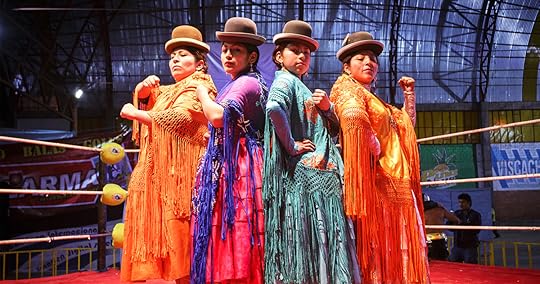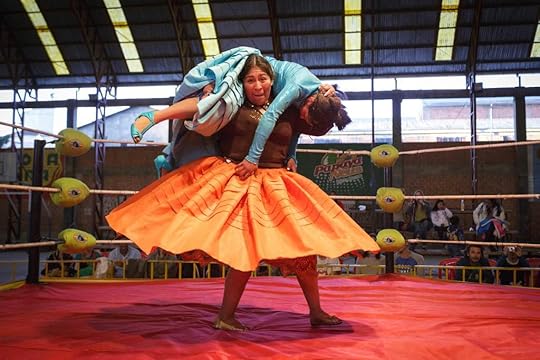Ripley Entertainment Inc.'s Blog, page 124
September 30, 2021
CARTOON 09-30-2021
September 29, 2021
Traditional Takedowns: The Wrestling Women of Bolivia
Featured in Ripley's Believe It or Not!

Poised atop a rope in a wrestling ring in Bolivia, you’ll find a woman dressed in a thick colorful skirt, her hair in swinging braids. In spite of the many voices that have told her she can’t, she leaps at her opponent.
View this post on Instagram
A post shared by Ripley’s Believe It or Not! (@ripleysbelieveitornot)
El Alto is a city of rebels. In 2003, the Bolivian gas conflict came to a head as residents of the country’s second-largest city pushed back against the exploitation of their natural gas. More than 60 indigenous people were killed and hundreds more were injured in their protest against the privatization of Bolivia’s natural resources. And atop the heads of the local women involved, an unexpected symbol of subversion could be spotted — bowler hats.

Editorial credit: Thomas Wyness / Shutterstock.com
Originally marketed toward men and seen as integral to the personal style of Winston Churchill and Charlie Chaplin, bowler hats made their way into the wardrobe of Bolivian women. Now, not only are they woven into the fabric of traditional attire, they can be seen perched on the heads of another group of women who challenge the norm. They’re known as the Fighting Cholitas.
What Are Cholitas?Originally used as an insult, words like “cholas” or “cholitas” were meant to offend indigenous women. It wasn’t until the Bolivian National Revolution in 1952 that Aymara and Quechua people gained essential rights like voting. For women specifically, the marginalization and oppression were even worse, and so they began to take control of the names that were used to belittle them.
The Fighting Cholitas do the same. This group of female wrestlers battled their way into a male-dominated field, proudly sporting a name that was once used to keep them down. While they take inspiration from modern wrestling and Lucha libre Mexicana, they don’t wear tight sequined costumes. Instead, they dress the way they would outside the ring, wearing traditional thick pollera skirts, petticoats, shawls, and two long braids under their bowler hats. There is pride in being a Cholita, and the women who take the Fighting Cholita name range in age from 15 to 70 with a variety of backgrounds.
Grappling With Traditional ExpectationsWrestling is perhaps the world’s oldest sport, and it was once the most brutal. Cave paintings dating back 15,000 years, reliefs, and mosaics have been found all recording men punching, grappling, and engaging in battle. When it was at peak popularity in Greece, the “barea athla” (heavy contests), like wrestling and boxing, were saturated by men of great size and strength.

Image credit: Zzvet / Shutterstock.com
Lucha libre, similarly, was made popular because of the machismo air that surrounded the spectacle. But, in time, the female children in wrestling families longed for their moment inside the ring. Today, women have fought their way into the world of Lucha, and they’re known as Luchadoras.
Being an indigenous woman and trying to break into wrestling is not an easy move. For the Fighting Cholitas, it took years to be allowed in the same room as their male counterparts. And dressing like themselves, in traditional garments and heavy flowing skirts, added to the ridicule they faced. Many doubted their ability to perform in such clothes, instead of the tight and flashy outfits embraced in other wrestling realms.
Ana Polonia Choque was one of the first female wrestlers in Bolivia in the early 2000s. Her stage name is Carmen Rosa, La Campeona, and she began with a group of just four women. Some were looking for an outlet to vent amid domestic violence and a rise in femicide. She pushed past the doubt of men and even her fellow indigenous women who worried she brought shame to their polleras (the traditional skirts). She, and her fellow cholas, wrestle because they love it, and to prove that there is strength in being a woman–in being an Aymara woman from Bolivia–and that there is pride, too. Today, a search for things to do in El Alto will bring watching Cholitas wrestling to the top.

Editorial credit: sunsinger / Shutterstock.com
When they began, the male managers and organizers were taking a huge cut of their profits. This led them to form the women-only group called the Cholitas Wrestling Foundation. But, they don’t profit enough for wrestling to be their only gig. Carmen, for example, has run a small restaurant for years. The Fighting Cholitas consist of a variety of Bolivian women, some single mothers, some working more than one job on the side. They support themselves, their families, and the dreams of women everywhere who want equality.
It’s Not Fake, It’s KayfabeIn the same way that the stage in something like WWE is almost like that of a theater, the Cholitas dress up, play a part, and put on an athletic display for crowds. There is a hero and a villain character, and they tell a story through their wrestling. This illusion is known in the wrestling world as kayfabe. While some people call this type of wrestling “fake,” the moves, strength, and skill are all real. The falls and strain are real, too, and have landed some of the Cholitas wrestlers in the hospital. Naysayers who believe that the Cholitas aren’t incredible athletes are silenced when watching their talent in the ring. These Bolivian women continue to push past the opponents in their way. And though the pandemic put a temporary halt to their wrestling, it didn’t keep them pinned for long—they’re ready for the next match.

Editorial credit: sunsinger / Shutterstock.com
Take Your Own Step Out of the Box!Challenge yourself to get a little weird, try new things, and step out of your comfort zone with inspiration from Ripley’s Believe It or Not! Out of the Box, available now on Amazon and at most major retailers.
By Kelsey Roslin, contributor for Ripleys.com
STEP OUTSIDE OF YOUR COMFORT ZONE Experience the stories of adventurers near and far, from a three-year-old mountain climber to hair-hangers and acrobats. Leave inspired by unbelievable talents, breathtaking bucket list-worthy locations, and curious discoveries, all from people just like you as you uncover the pages of Ripley’s newest annual book!Source: Traditional Takedowns: The Wrestling Women of Bolivia
CARTOON 09-29-2021
September 28, 2021
CARTOON 09-28-2021
September 27, 2021
CARTOON 09-27-2021
September 26, 2021
CARTOON 09-26-2021
September 25, 2021
CARTOON 09-25-2021
September 24, 2021
Taxi Graveyard Garden Used To Feed Bangkok Drivers
Featured in Ripley's Believe It or Not!

It’s no secret that businesses worldwide have been hit hard by the COVID-19 pandemic, with industries dependent on people being out and about struggling to survive.
Since March 2020, Bangkok taxi company Ratchapruk and Bovorn Taxi has been holding on by a thread as Thailand’s tough COVID-19 restrictions left the bustling city’s streets quiet.
With passengers nowhere to be found and no other options, a slew of the company’s drivers hightailed it to the safety of their home villages, abandoning their cars in carports and gas stations as they got out of Dodge.
Embed from Getty Imageswindow.gie=window.gie||function(c){(gie.q=gie.q||[]).push(c)};gie(function(){gie.widgets.load({id:'ioMl7LASQMRk7SVxVV9wjQ',sig:'zS99rQESJCTWRUomvPtBr9VOQgAVrGB7XfmzhWNqn20=',w:'594px',h:'396px',items:'1235265668',caption: false ,tld:'com',is360: false })});
Though some attempted to ride out the pandemic, once the second wave rolled in, the income decrease proved too much to withstand, with most drivers unable to cover the company’s daily driver fee, which had already been cut down to 300 baht ($9.09)—half of its usual cost.
After enduring several additional waves, Thailand hit its deadliest numbers in Aug. 2021, accounting for 97% of its total cases and 99% of deaths.
During that time, the company amassed a “taxi graveyard” of 2,500 vehicles and a mountain of debt to the tune of 2 billion baht ($60.8 million) from the initial purchase of the fleet.
With no direct assistance offered by the government, Ratchapruk and Bovorn executive Thapakorn Assawalertkul says if the company doesn’t receive help soon, they will be in “real trouble.”
Embed from Getty Imageswindow.gie=window.gie||function(c){(gie.q=gie.q||[]).push(c)};gie(function(){gie.widgets.load({id:'BI0bpQ8KTUVREt8Rk4LpSg',sig:'L-T541SJ2pqVz2pD5zo_WaU3cZReTKeHoJyCOw65Zmo=',w:'594px',h:'396px',items:'1235265637',caption: true ,tld:'com',is360: false })});
Rather than continue to let the cars sit idle, the company has turned the fleet into rooftop gardens as a means to help feed its remaining employees and their families.
Staff who took a salary cut and remained in the city built the car gardens by stretching black garbage backs across the rooftops with bamboo frames, adding soil and seeds to grow tomatoes, cucumbers, string beans, and more.
The beauty of an urban garden sprouting out of the colorful cars looks more like an art installation than the response to a deadly virus, a vision intended by the company, who hopes it will serve as a form of protest and draw attention to the plight of taxi drivers during the lockdown.
Embed from Getty Imageswindow.gie=window.gie||function(c){(gie.q=gie.q||[]).push(c)};gie(function(){gie.widgets.load({id:'HyTQUVJVSSd9WJvc34KD_Q',sig:'l0dAxxQV19kgzaTec9OZGI4LYTyATYEaRLEGbNZoELc=',w:'594px',h:'396px',items:'1235265357',caption: true ,tld:'com',is360: false })});
By Meghan Yani, contributor for Ripleys.com
EXPLORE THE ODD IN PERSON! Discover hundreds of strange and unusual artifacts and get hands-on with unbelievable interactives when you visit a Ripley’s Odditorium!CARTOON 09-24-2021
September 23, 2021
CARTOON 09-23-2021
Ripley Entertainment Inc.'s Blog
- Ripley Entertainment Inc.'s profile
- 52 followers











